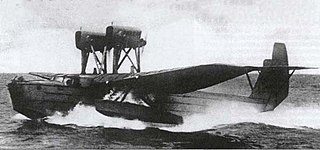Related Research Articles

The Beriev Be-12 Chayka is a Soviet turboprop-powered amphibious aircraft designed in the 1950s for anti-submarine and maritime patrol duties.

The Aichi E11A was an Imperial Japanese Navy flying boat used during the first year of World War II for maritime patrol duties. The Allied reporting name for the type was "Laura"; the Japanese Navy designation was "Type 98 Reconnaissance Seaplane". The Type 98 was quite similar to the earlier E10A Type 96, whose allied name was "Hank". "Lauras" were rare - only 17 were built. It was designed to be launched from cruisers or battleships in order to spot their shellfire at night. The Type 98s were soon diverted to communications and transport duties.

The Yokosuka H5Y or Yokosuka Navy Type 99 Flying Boat Model 11, given the allied code name Cherry, was an IJNAS flying boat in service from 1938.

The Aichi E16A Zuiun was a two-seat reconnaissance seaplane operated by the Imperial Japanese Navy during World War II.

The SIAI S.8 was an Italian 1910s two-seat reconnaissance flying boat.

The Savoia-Marchetti SM.78 was an Italian bomber/reconnaissance biplane flying boat of the early 1930s.

The Savoia-Marchetti SM.62 was an Italian single-engine maritime patrol flying boat produced from 1926. It served with the Regia Aeronautica and with a number of foreign users, and was licence-produced in Spain and the Soviet Union. Some of the Spanish aircraft were still in service during the Spanish Civil War

The FBA Type 310 was a 1930s French touring flying boat or amphibian built by the Franco-British Aviation Company.

The ANT-8 was an experimental flying boat designed by Tupolev. It was designated the "MDR-2" by the military.

The Supermarine Sea Eagle was a British, passenger–carrying, amphibious flying boat. It was designed and built by the Supermarine Aviation Works for its subsidiary, the British Marine Air Navigation Co Ltd, to be used on their cross-channel route between Southampton, the Channel Islands and France.

The FBA 19 was a flying boat bomber developed in France in 1924 by Franco-British Aviation.

The Lohner L was a reconnaissance flying boat produced in Austria-Hungary during World War I. It was a two-bay biplane of typical configuration for the flying boats of the day, with its pusher engine mounted on struts in the interplane gap. The pilot and observer sat side by side in an open cockpit, and both the upper and lower sets of wings featured sweepback.
The Aichi AB-4 was a Japanese flying boat of the 1930s. A single engined biplane, the AB-4 was intended to carry out night reconnaissance for the Imperial Japanese Navy. Six were built and accepted into service as the Experimental 6-Shi Night Reconnaissance Flying boat, three of which were converted to civil transports.

The Aichi E10A was a Japanese night reconnaissance flying boat of the 1930s. A single-engined biplane, 15 were built for the Imperial Japanese Navy as the Type 96 Night Reconnaissance Seaplane, serving from 1936 but were retired in 1941 before the Attack on Pearl Harbor.

The Besson H-5 was a French transport quadruplane flying boat designed by the Marcel Besson company of Boulogne. The only H-5 was damaged and development was abandoned.

The Kawanishi E11K was a Japanese flying boat of the 1930s. It was designed as a night reconnaissance aircraft for the Imperial Japanese Navy, but was not accepted, the two aircraft built being used as transports as the Type 96 Transport Flying Boat during the Second World War.
The FBA 13 was a trainer flying boat built in France in the early 1920s.
The FBA 16 HE2,, was a flying boat trainer built in France in the early 1920s.
The FBA 270 was a flying boat trainer built in France in the early 1920s.
The CANT 35 was an Italian reconnaissance flying boat built by CANT in the early 1930s.
References
- ↑ "F.B.A. 10 HM - Amphibie de reconnaissance - Un siècle d'aviation française". Aviafrance.com. 2016-11-08. Retrieved 2022-08-31.